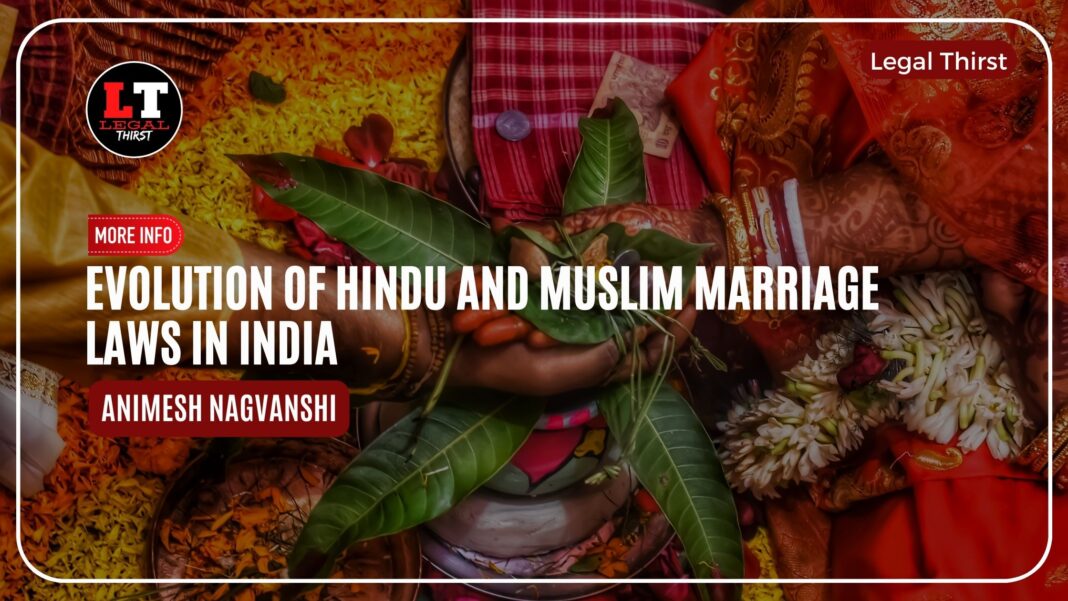Table of Contents
INTRODUCTION:
A complex interplay of religious, cultural, and historical factors has shaped the evolution of Hindu and Muslim marriage laws in India. Hindu and Muslim communities had different laws governing marriage and divorce based on their respective religious texts and customs. But, with the advent of British colonial rule in India, several laws were introduced. They codify and standardize marriage and divorce practices across different communities. In recent years, there has been ongoing debate and discussion about further reforming Hindu and Muslim marriage laws in India. They have focused on issues such as gender equality and women’s rights.
CONTRIBUTORY FACTORS IN THE EVOLUTION OF HINDU AND MUSLIM MARRIAGE LAWS IN INDIA:
Religious beliefs
- Hindu and Muslim marriage laws were based on religious texts and teachings, which had a significant impact on shaping the laws.
Cultural practices
- Traditional practices and customs of the Hindu and Muslim communities also played a vital role in the laws’ development.
British colonial influence
- The British introduced their laws and legal systems in India, which had a lasting impact on the laws in the country. They also introduced the concept of codified laws, which helped to form the Hindu Marriage Act of 1955 and the Muslim Personal Law (Shariat) Application Act of 1937.
Social and economic changes
- Changes in society’s social and economic conditions have influenced the evolution of laws over time. For example, increasing education and employment opportunities for women have led to law changes.
Changing societal norms and values
- The laws have undergone changes and amendments over the years, reflecting society’s changing perspectives and needs, such as the need for gender equality and the protection of women’s rights. significantly shaped
Hindu & Muslim Marriage Laws Key Provisions
The Hindu Marriage Act of 1955 and the Muslim Personal Law (Shariat) Application Act of 1937 were two key laws that regulated marriage, divorce, and inheritance for Hindus and Muslims in India, respectively.
The key provisions of the Hindu Marriage Act of 1955 include the following:
- Establishing the legal framework for marriage, divorce, and inheritance for Hindus, Buddhists, Jains, and Sikhs.
- Amending the minimum age of marriage to 18 for males and 14 for females.
- It recognizes monogamy as the legal norm for marriage.
- It provides various grounds for divorce, including cruelty, desertion, and adultery.
- It makes provisions for maintenance and property rights. Thereby creating a sense of responsibility among married couples.
- It provides various rights to women such as the right to seek divorce and the right to inherit property.
The key provisions of the Muslim Personal Law (Shariat) Application Act of 1937 are as follows:
- It recognizes the application of Islamic law in matters of marriage, divorce, and inheritance for Muslims in India.
- It has provisions related to maintenance & property rights. Thereby creating a sense of responsibility among married couples.
- It deals with the right of women to seek divorce and inherit property.
- It allows Muslim men to practice polygamy and divorce through talaq-e-bidder (triple talaq). Apex court of India later declared it unconstitutional and struck it down in 2017.
It’s worth mentioning that both laws have undergone several changes and amendments over the years. To align with changing perspectives and needs of society, such as the need for gender equality and the protection of women’s rights.
IMPROVEMENT
Various factors, including religious, cultural, and historical influences, have influenced the evolution of Hindu and Muslim marriage laws in India. Historically, Hindu and Muslim communities had different laws governing marriage and divorce based on their respective religious texts and customs.
Hindu marriage laws, for instance, originated from ancient texts such as the Manusmriti and the Dharmasastras. These texts outlined the rules and regulations governing marriage and divorce and were considered authoritative by Hindu scholars and jurists.
To create a uniform set of laws governing marriage and divorce for Hindus, Buddhists, Jains, and Sikhs, the Hindu Marriage Act of 1955 was passed. This law established the legal minimum age for marriage, introduced the concept of monogamy, and established a process for divorce.
During the British colonial period, laws were introduced to regulate Muslim marriage and divorce practices. For instance, the Muslim Personal Law (Shariat) Application Act of 1937 recognized the authority of Islamic law in matters of marriage, divorce, and inheritance among Muslims in India.
Recently, there has been ongoing debate and discussion about further reforming Hindu and Muslim marriage laws in India. Some argue that the current laws are outdated and do not adequately protect the rights of women and girls, particularly in areas such as divorce and inheritance. Others argue that any changes to the laws should be made in consultation with religious leaders and scholars to ensure that they align with traditional religious beliefs and practices.
In summary, the evolution of Hindu and Muslim marriage laws in India has been shaped by various factors over time. While significant changes and revisions have been made, further reform is still needed to protect the rights of women and girls.
LANDMARK CASES
Several landmark cases have shaped the evolution of Hindu and Muslim marriage laws in India. Some of the most notable ones include:
- Shah Bano case (1985) –
This case involved a Muslim woman, Shah Bano, who was divorced by her husband and sought maintenance under the Indian Muslim Personal Law. The Supreme Court of India ruled in her favour, stating that Muslim women were entitled to maintenance after divorce. However, the ruling led to widespread protests from Muslim groups. It ultimately led to the passing of the Muslim Women (Protection of Rights on Divorce) Act, which limits the maintenance that Muslim women can claim. - Danial Latifi v. Union of India (2001) –
This case involved a Muslim woman, Danial Latifi, whose husband divorced her through triple talaq. The Supreme Court of India held that the instant triple talaq practice was unconstitutional and violated the fundamental rights of Muslim women. - Joseph Shine v. Union of India (2018) –
This case challenged the constitutional validity of Section 497 of the Indian Penal Code, which criminalized adultery. The Supreme Court of India struck down the provision, stating that it discriminated against women and violated their right to equality.
These cases and the judgments passed on them have helped shape the evolution of Hindu and Muslim marriage laws and give women more rights under these laws.
TIMELINE OF EVOLUTION
- In 2020, the Indian government proposed a new bill called the ‘Muslim Women (Protection of Rights on Marriage) Bill. It was passed by the Indian Parliament in 2021. This bill aimed to criminalize the practice of instant triple talaq among Muslims.
- In 2019, the Indian government introduced a bill to criminalize the practice of instant triple talaq or “talaq-e-bidder” among Muslims. The Indian Parliament passed the bill, which became law in 2019, making the practice of instant triple talaq a punishable offence.
- In 2018, The Muslim Women (Protection of Rights on Marriage) Bill was introduced in the Indian Parliament. It sought to criminalize the practice of instant triple talaq among Muslims. The bill was passed by the Indian Parliament and became law in 2019.
- In 2017, The Supreme Court of India struck down the practice of instant triple talaq as unconstitutional and violative of Muslim women’s rights in the case of Shayara Bano v. Union of India.
- In 2016, the Indian government established the Law Commission of India to review Indian Muslim personal laws. They aimed to recommend measures for uniformity and reform.
- In 2015, The Hindu Succession (Amendment) Act 2005 came into effect, granting daughters equal property rights as sons.
CONCLUSION
In conclusion, the evolution of Hindu and Muslim marriage laws in India is influenced by cultural, religious, and political factors. The British colonial influence significantly impacted the development of these laws. The introduction of personal laws for different communities during the colonial period laid the foundation for the current legal framework. Over time, the laws have undergone changes and reforms to cater to India’s social & economic needs. Some landmark cases that have shaped the evolution of these laws include the Shah Bano case, Danial Latifi v. Union of India, and Joseph Shine v. Union of India. These cases have helped give women more rights under these laws and helped evolve marriage laws in India.
REFERENCES
- Personal Laws of Hindu and Muslim in India, Saksham CHHABRA, https://blog.ipleaders.in/hindu-law/
- Features Of Hindu Marriage That Is Changing And Evolving, Manas Dwivedi, https://www.legalserviceindia.com/legal/article-7398-features-of-hindu-marriage-that-are-changing-and-evolving.html
- EVOLUTION OF HINDU MARRIAGE LAWS TOWARDS LIBERALISATION, Indian Review of Advanced Legal Research, https://www.iralr.in/post/evolution-of-hindu-marriage-laws-towards-liberalisation
- All You need to know about the Hindu Marriage Act, 1955, Taxmann, https://www.taxmann.com/post/blog/569/all-you-need-to-know-about-the-hindu-marriage-act-1955/#:~:text=Hindu%20Marriage%20Act%2C%201955%20incorporated,the%20Hindu%20Marriage%20Act%2C%201955.
- Concepts of Marriage and Divorce under Hindu and Muslim Law, Subodh Asthana & Ishita Pal, https://blog.ipleaders.in/marriage-divorce-hindu-muslim-laws/
- History of legal marriage age for women in India, Sameer Khan, https://www.siasat.com/history-of-legal-marriage-age-for-women-in-india-2242449/
- A short history of Muslim personal law in India, Shoaib Daniyal, https://scroll.in/article/849068/a-short-history-of-muslim-personal-law-in-india
Disclaimer: The opinions and views in the articles and research papers published on this website; are personal and independent opinions of the author. The website is not responsible for them.
Legal Thirst has created a telegram group for exchanging legal knowledge, Events, and various opportunities.
You can click on this link and join:
Follow Legal Thirst on Instagram and Subscribe to our YouTube channel for more amazing legal content.

